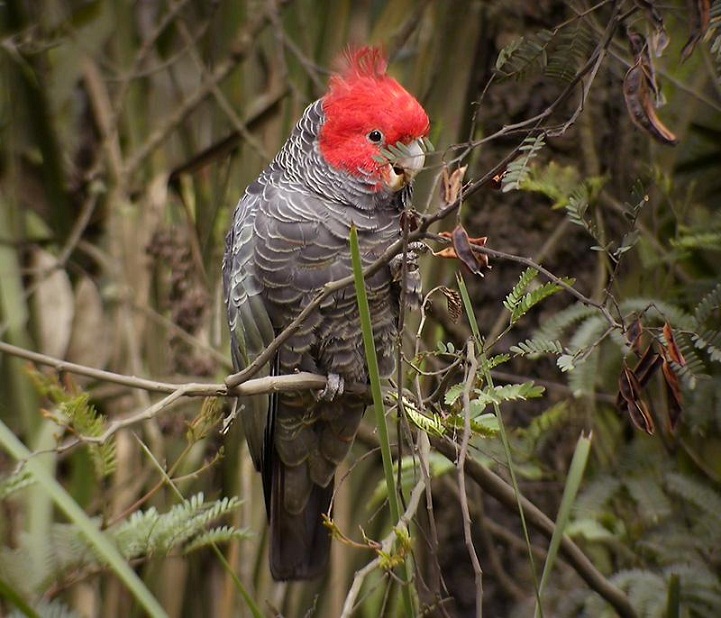

Gang-gang Cockatoos retreat to higher elevations to breed during the summer.

This has given Gang-gangs the nicknames Red-headed Cockatoo and Red-crowned Cockatoo.ĭuring the winter, when breeding season is over, Gang-gang Cockatoos can be found in the south-eastern parts of Australia, including Victoria, New South Wales, Australian Capital Territory, and South Australia. The dark red of their crest and head stands out against their slate grey bodies. Male Gang-gang Cockatoos are easily distinguished by their wispy red crest, which looks like a feather duster. Female Gang-gang cockatoos can sometimes be mistaken for Galahs due to their colouring and small size.

The females are not as brightly coloured as the males, and have a grey head and body with a barred breast and orange-red underparts. Gang-gang Cockatoos are small for cockatoos, usually around 33-36 cm long. The Gang-gang Cockatoo ( Callocephalon fimbriatum) is a small cockatoo with the male displaying a very distinctive scarlet head and crest. Their diet is varied and adaptable, and includes native plant seeds, introduced plant seeds, berries, fruits, nuts and insect larvae. Gang-gangs spend most of their day feeding in trees, and sometimes also forage on the ground for fallen fruits or pine cones.These sharp and distinct sounds are characteristic of cockatoos, who are usually quite loud and gregarious. These calls have been likened to the drawn out sounds of a cork being removed from a bottle, and a rusty hinge on a gate. Apart from softly growling while eating, Gang-gang Cockatoos communicate in an ‘er-eck‘ or a ‘ gr-raer-iriek!‘ sound.They choose to live in mountains, alpine woodlands and tall wet forests and gullies, preferring heavily timbered and mature wet sclerophyll forests to build their home They are especially frequent visitors in Canberra, and as a reward for their loyalty have become the ACT’s animal emblem. They prefer eucalypts, wattles and introduced hawthorns and will also eat berries, fruits, nuts and insects and insect larvae. Gang-gang Cockatoos regularly visit backyards and parks in eastern Australia to feed on native and introduced tree and shrub seeds. This has given Gang-gangs the nicknames Red-headed Cockatoo and Red-crowned Cockatoo. At times they just feed quietly on gum nuts in the upper foliage and you only notice them from the sound of the pattering of gum nut fragments as you walk underneath.The Gang-gang Cockatoo ( Callocephalon fimbriatum) are small for cockatoos, usually around 33-36 cm long. Male Gang-gang Cockatoos are easily distinguished by their wispy red crest, which looks like a feather duster. Although they often move about in groups, unlike the other more noisy cockatoos they are often fairly quiet. One of its distinctive calls is a creaking sound that identifies it easily. There have been a few isolated examples of hybridisation with Galah and one with a Little Corella.Īnd as an inhabitant of the forests, it is often heard before it is seen. In spite of their colour, they are more closely related to Galahs than they are to the Black Cockatoos. Taxonomically they are in a separate genus from the other cockatoos (Callocephalon). Males can be distinguished by their distinctive red head with its wispy crest. Unlike other members of the cockatoo family who stand out with their colour and raucous noise, the Gang Gang can be quite unobtrusive with its overall grey plumage. Gang Gang Cockatoo ( Callocephalon fimbriatum) We are blessed to have the brilliant Jane Rusden and Damian Kelly from BirdLife Castlemaine District writing about our next bird of the month, accompanied by Janes’s stunning photos. We’re excited to join forces to deliver you a different bird each month, seasonally adjusted, and welcome suggestions from the community. Each month we’re taking a close look at one special local bird species. Welcome to Bird of the month, a partnership between Connecting Country and BirdLife Castlemaine District.


 0 kommentar(er)
0 kommentar(er)
